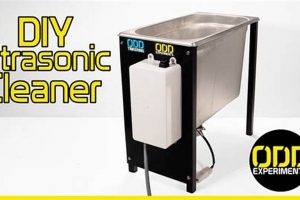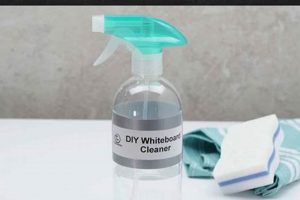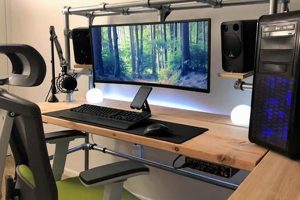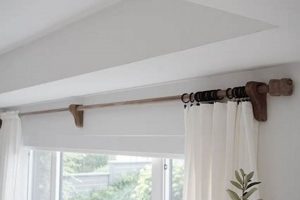The construction of personalized audio playback devices that utilize wireless connectivity has become increasingly popular. This process involves assembling individual components such as amplifier circuits, speaker drivers, power sources, and Bluetooth receiver modules to create a functional, self-made sound system. An example involves acquiring a pre-fabricated enclosure, integrating a small amplifier board, pairing it with a Bluetooth module, and wiring it to a full-range speaker for portable audio streaming.
The advantages of this type of construction lie in the ability to tailor the device to specific needs and aesthetic preferences, potentially at a lower cost than commercially available products. Furthermore, engaging in such projects provides opportunities for educational growth in electronics, acoustics, and design. The practice of building custom audio devices has evolved alongside the proliferation of affordable electronic components and accessible online resources, transitioning from a niche hobby to a more mainstream pursuit.
The subsequent sections will delve into the various aspects of planning, designing, constructing, and troubleshooting such projects. This includes selecting suitable components, understanding circuit diagrams, mastering soldering techniques, and optimizing sound quality. We will also explore advanced concepts like enclosure design and active crossover implementation.
DIY Bluetooth Speaker
Successfully building a custom audio device requires careful planning and execution. The following tips provide guidance to ensure a robust and functional finished product. Attention to detail at each stage of the process is crucial for optimal performance.
Tip 1: Component Selection: Selecting components based on specified criteria is paramount. Prioritize amplifier boards with power output matching the speaker’s impedance and power handling capabilities. Bluetooth modules should support the desired audio codecs (e.g., aptX, AAC) for optimal audio quality. Consider datasheets and reviews to ensure reliability.
Tip 2: Power Supply Considerations: Power supply selection is critical for reliable operation. Ensure the power supply voltage matches the requirements of the amplifier board and Bluetooth module. Utilize a regulated power supply to minimize noise and prevent voltage fluctuations. Battery-powered projects require careful selection of batteries and charging circuitry.
Tip 3: Enclosure Design & Material: The enclosure significantly impacts sound quality. Utilize materials like MDF or hardwood for improved resonance characteristics. Calculate internal volume based on speaker specifications for optimal bass response. Properly sealing the enclosure prevents air leaks that can degrade performance.
Tip 4: Soldering Technique: Proper soldering is essential for reliable electrical connections. Employ a temperature-controlled soldering iron and quality solder. Ensure clean connections by pre-tinning wires and component leads. Inspect solder joints for cold solder joints or shorts using a magnifying glass.
Tip 5: Wiring & Connections: Utilize appropriate gauge wire for power and signal connections. Shielded cables minimize noise and interference. Securely attach connectors using methods like crimping or soldering. Follow a well-documented wiring diagram to prevent errors.
Tip 6: Testing & Troubleshooting: Test each stage of the project to identify potential issues early. Use a multimeter to verify voltage levels and check for continuity. Employ an oscilloscope to analyze signal waveforms. Document all troubleshooting steps for future reference.
Tip 7: Safety Precautions: Exercise caution when working with electrical components. Always disconnect the power supply before making any modifications. Use appropriate personal protective equipment such as safety glasses and gloves. Dispose of electronic waste responsibly.
These tips emphasize the importance of careful planning, precise execution, and attention to safety when engaging in custom audio device construction. Adhering to these guidelines will increase the likelihood of a successful and enjoyable project, resulting in a well-performing and aesthetically pleasing finished product.
The article will now proceed to discuss common issues encountered during the construction phase and offer solutions to address them effectively.
1. Component Selection
The selection of appropriate components exerts a direct and substantial influence on the performance characteristics of a custom-built audio device. Each component within the system, from the amplifier module to the speaker driver, contributes to the overall sound quality, power output, and operational lifespan. Inadequate component selection can result in diminished audio fidelity, instability, and premature failure. For instance, pairing a low-power amplifier with high-impedance speakers may produce insufficient volume, while using an under-rated power supply could lead to distortion or damage to the amplifier. A critical step in any successful project involves detailed specification analysis and matching component characteristics to achieve design goals.
Different types of components will impact the sound quality. For example, cheap amplifier modules often introduce unwanted noise and distortion into the audio signal, degrading the overall listening experience. Similarly, low-quality Bluetooth modules might exhibit connection instability and limited codec support, hampering wireless audio streaming. In contrast, selecting reputable components from established manufacturers typically results in a more robust and predictable outcome. Consider selecting a component with a wide frequency response range to maintain clarity of the high pitch and richness in the lows.
Therefore, the connection between component selection and the ultimate functionality of a custom Bluetooth speaker is inextricable. A system’s overall performance reflects the quality and suitability of its individual constituents. Careful consideration of component specifications, compatibility, and reliability is essential for achieving optimal performance and longevity in any audio construction endeavor. The choice of components dictates the final project sound quality.
2. Power Management
Effective power management is critical for the successful operation and longevity of custom-built audio devices. Given the diverse range of components utilized in such projects, ensuring a stable and efficient power supply is essential for optimal performance and preventing component damage. A properly designed power system addresses voltage regulation, current delivery, and battery management, directly impacting the sound quality and operational reliability of the completed device.
- Voltage Regulation
Voltage regulation maintains a constant voltage output despite variations in input volt
age or load current. Fluctuations in voltage can lead to audio distortion, unstable Bluetooth connectivity, and potential damage to sensitive electronic components. Voltage regulators, such as linear regulators or switching regulators, provide a stable voltage source, ensuring consistent performance across varying operating conditions. For example, a 5V regulator may be used to provide power to both the bluetooth module and amplifier component. - Current Delivery
Adequate current delivery ensures the amplifier and other components receive sufficient power to operate within their specified parameters. Insufficient current can result in reduced power output, clipping, and distortion. Selecting a power supply with a current rating that exceeds the combined requirements of all components is crucial. For example, a class D amplifier module with an output of 10W at 4 ohms may require a minimum of 2.5A, but a power supply capable of delivering 3A or more is preferred to prevent current limiting.
- Battery Management (if applicable)
For portable devices, battery management becomes a central consideration. This includes selecting appropriate battery chemistry (e.g., Lithium-ion, Lithium Polymer), implementing charging circuitry, and providing protection against over-charging, over-discharging, and short circuits. Integrated battery management systems (BMS) often incorporate these functions, optimizing battery life and ensuring safe operation. For example, using a BMS for a lithium-ion battery pack will prevent damage to the cells from over-discharge and will prolong the battery lifespan.
- Power Efficiency
Power efficiency relates to the minimization of power losses in the circuit, thereby reducing heat generation and increasing battery life (in battery-powered applications). Components with higher efficiency ratings are preferred. Switching power supplies, for example, generally offer higher efficiency compared to linear regulators, reducing the overall power consumption and extending the operational duration of the speaker system. Choosing energy-efficient amplifier types also aids in power efficiency.
The aforementioned facets of power management collectively define the operational characteristics and long-term reliability of such construction projects. A carefully planned power system not only guarantees consistent audio performance but also mitigates the risk of component failures and extends the device’s lifespan. Ignoring these considerations can result in a compromised user experience and costly repairs.
3. Enclosure Design
Enclosure design significantly influences the acoustic characteristics and overall performance of a custom audio playback device. The enclosure serves not merely as a housing for electronic components but as an integral element in shaping the sound produced by the speaker driver. Factors such as enclosure volume, material composition, and porting configuration directly affect frequency response, bass extension, and overall sound clarity.
- Internal Volume and Driver Matching
The internal volume of the enclosure must be carefully matched to the Thiele/Small parameters of the speaker driver. These parameters, provided by the driver manufacturer, define the driver’s mechanical and electrical characteristics. Utilizing an enclosure volume that deviates significantly from the driver’s recommended volume can result in poor bass response, reduced efficiency, and potential damage to the driver. Software simulations and calculations are frequently employed to optimize the enclosure volume for a given driver.
- Material Selection and Resonance
The material used for the enclosure walls impacts its resonant properties. Materials such as Medium Density Fiberboard (MDF) and plywood are commonly chosen for their damping characteristics, which minimize unwanted vibrations and resonances. Inadequate damping can lead to coloration of the sound, blurring of detail, and a generally muddied sonic presentation. The use of bracing and internal damping materials further reduces unwanted resonances.
- Porting and Bass Response
Porting, or the addition of a tuned vent to the enclosure, can extend the low-frequency response of the speaker system. The port acts as a Helmholtz resonator, reinforcing frequencies near the tuning frequency. Improperly designed ports can introduce unwanted resonances, distortion, and a boomy bass response. Accurate calculation of port dimensions, based on enclosure volume and desired tuning frequency, is crucial for achieving optimal results.
- Sealing and Air Leaks
Maintaining an airtight seal within the enclosure is essential for proper operation, particularly in ported designs. Air leaks can degrade bass response, reduce efficiency, and introduce unwanted noise. All joints and seams must be carefully sealed with adhesives or gaskets to prevent air from escaping. Regular inspection and maintenance are necessary to ensure the integrity of the seal over time.
These considerations collectively highlight the crucial role of enclosure design in shaping the acoustic performance of a custom audio project. Optimal enclosure design, informed by driver parameters, material properties, and acoustic principles, is essential for realizing the full potential of the speaker system and achieving a high-quality listening experience.
4. Soldering Proficiency
Soldering proficiency constitutes a foundational skill in the successful construction of custom audio playback devices. The reliability and performance of these devices hinge significantly on the quality of the soldered connections that join electronic components. Inadequate soldering can lead to intermittent operation, signal degradation, and premature failure of the entire system, negating the benefits of carefully selected components and well-designed enclosures.
- Electrical Connectivity
Soldering establishes a secure electrical connection between components, ensuring unimpeded signal flow and power delivery. A poorly executed solder joint may exhibit high resistance, impeding current flow and introducing noise into the audio signal. This can manifest as distortion, reduced volume, or complete signal loss. Proper soldering techniques minimize resistance and ensure a clean, reliable electrical pathway.
- Mechanical Integrity
In addition to electrical conductivity, soldering provides mechanical strength, physically securing components to circuit boards and wires. A weak solder joint is susceptible to fracture from vibration, temperature changes, or physical stress. This can result in intermittent connections and unpredictable device behavior. Robust solder joints withstand mechanical stress, contributing to the overall durability and longevity of the audio device. For example, stress will naturally occur on various parts of the system such as when plugging and unplugging cables from different ports.
- Component Protection
Proper soldering techniques minimize heat exposure to sensitive electronic components. Excessive heat can damage components, altering their electrical characteristics or causing them to fail outright. Skilled soldering involves using a temperature-controlled soldering iron, applying heat quickly and efficiently, and employing
heat sinks to dissipate excess heat. This protects components from thermal damage, ensuring their proper function and extending their lifespan. - Prevention of Short Circuits
Precise soldering prevents unintentional bridging of adjacent conductors, avoiding short circuits. Excess solder or stray solder filaments can create unintended connections, leading to malfunction or component damage. Careful application of solder and thorough inspection of solder joints are essential for preventing short circuits and ensuring the safe and reliable operation of the audio device. For example, closely spaced pins of integrated circuits and Bluetooth modules require meticulous soldering to prevent bridging.
The implications of soldering proficiency extend beyond basic functionality, directly impacting the overall quality and reliability of custom audio devices. Masterful soldering techniques, encompassing proper heat management, precise application, and thorough inspection, are therefore indispensable for achieving optimal performance and guaranteeing the longevity of these DIY audio projects.
5. Wiring Integrity
Wiring integrity represents a critical, yet often overlooked, aspect of custom audio device construction. It encompasses the quality of electrical connections, cable management, and overall adherence to established wiring practices. Neglecting these elements can result in compromised audio performance, unreliable operation, and potential safety hazards. Proper wiring ensures that electrical signals are transmitted efficiently and reliably, thereby maximizing the potential of the individual components within the system.
- Signal Transmission Quality
The quality of wiring directly impacts the integrity of the audio signal. Substandard wiring can introduce noise, interference, and signal attenuation, degrading the overall sound quality. Shielded cables, proper grounding techniques, and the avoidance of ground loops are essential for minimizing these effects. An example is the use of shielded audio cables to connect the bluetooth module to the amplifier to prevent unwanted electromagnetic noise that can be picked up. This can lead to an improved signal to noise ratio.
- Power Delivery Efficiency
Adequate wire gauge and secure connections are crucial for efficient power delivery to the amplifier and other components. Undersized wiring can result in voltage drops and reduced power output, while loose connections can cause intermittent operation or even complete failure. Using appropriate gauge wire for power and signal connections helps ensure reliable power and consistent device function. For instance, thicker gauge wires should be used between the power source and the amplifier to minimize losses that can happen in the cable.
- Component Protection and Longevity
Proper wiring practices help protect electronic components from damage caused by short circuits, overloads, or reverse polarity. Fuses, circuit breakers, and polarized connectors are essential safety features that prevent damage and ensure the longevity of the system. Utilizing a fuse between the power source and the amplifier protects the components from a short circuit or excessive current draw. The correct fuse rating must be used according to the specifications of the electrical components in the system.
- Cable Management and System Reliability
Organized cable management improves airflow, reduces the risk of accidental disconnections, and simplifies troubleshooting. Clearly labeled wiring and secure cable routing enhance the overall reliability and maintainability of the device. For example, using zip ties to group wires together prevents them from obstructing airflow around heat-sensitive components. This makes tracing issues quicker and simpler, which improves airflow.
The elements of wiring integrity, encompassing signal transmission quality, power delivery efficiency, component protection, and cable management, are inextricably linked to the overall success of building custom audio solutions. The meticulous attention to detail in these domains is crucial for achieving optimal performance, ensuring long-term reliability, and mitigating potential safety hazards inherent in electrical construction projects. High quality wiring plays a huge part to minimize long term risks for the audio system.
6. Testing Protocols
Rigorous testing protocols are indispensable for validating the functionality, performance, and safety of custom-built audio systems. These protocols encompass a systematic approach to evaluating various aspects of the device, from basic electrical connectivity to complex acoustic characteristics, ensuring that the final product meets the desired specifications and operates reliably over time.
- Continuity Testing
Continuity testing verifies the integrity of electrical connections, ensuring that circuits are complete and free from breaks or shorts. A multimeter is used to measure resistance between points in the circuit, confirming that current can flow as intended. For example, a continuity test applied to speaker wiring ensures the driver is properly connected to the amplifier output, preventing signal loss or damage due to an open circuit.
- Voltage and Current Measurement
Voltage and current measurements validate that the power supply is delivering the correct voltage and current to the amplifier, Bluetooth module, and other components. Deviations from the specified values can indicate a faulty power supply, wiring issues, or component malfunctions. For instance, measuring the voltage across the amplifier’s power terminals confirms that it is receiving the required voltage for optimal performance.
- Frequency Response Analysis
Frequency response analysis characterizes the audio system’s ability to reproduce sounds across the audible spectrum. Specialized equipment, such as a calibrated microphone and audio analyzer, is used to measure the speaker’s output at various frequencies. The resulting frequency response curve reveals any peaks, dips, or other anomalies that affect the tonal balance of the audio system. This is extremely important to the end quality of the sound from the custom-built speaker.
- Distortion Measurement
Distortion measurement quantifies the amount of unwanted harmonic or intermodulation distortion introduced by the amplifier and speaker. High levels of distortion can degrade the clarity and fidelity of the audio signal, making it sound harsh or muddy. A Total Harmonic Distortion (THD) analyzer is used to measure the percentage of distortion present in the output signal, ensuring that it remains within acceptable limits.
These facets of testing protocols directly influence the quality and safety of custom audio devices. By systematically evaluating electrical connectivity, power delivery, frequency response, and distortion characteristics, these protocols provide objective data that informs design modifications, component selection, and troubleshooting efforts. Adherence to rigorous testing standards is essential for realizing the full potential of these DIY projects and ensuring a satisfying listening experience.
7. Safety Awareness
The construction of custom audio devices necessitates a thorough understanding and application of safety principles. The inherent risks associated with electrical circuits, power tools, and hazardous materials require stringent adherence to safety guidelines to mitigate potential injuries and prevent equipment damage. A comprehensive safety awareness framework serves as a protective barrier, minimizing the likelihood of accidents throughout the design, construction, and operation phases of these projects.
- Electrical Shock Hazards
Exposure to hazardous voltages represents a primary concern in the assembly of electronic systems. Contact with energized circuits can result in severe burns, cardiac arrest, or death. The risk of electric shock is particularly pronounced during the testing and troubleshooting phases, where direct access to live circuits may be necessary. Implementation of safety measures, such as utilizing isolation transformers, wearing insulated gloves, and ensuring proper grounding, are crucial for mitigating this risk. Furthermore, disconnecting the power supply before making any modifications or adjustments is paramount in preventing electrical accidents.
- Fire Hazards
Overcurrent conditions, short circuits, and component failures can initiate fires within electronic devices. The use of flammable materials in the enclosure construction or the improper handling of batteries can exacerbate this risk. Installation of fuses and circuit breakers provides overcurrent protection, while the use of flame-retardant materials minimizes the spread of fire. Careful monitoring of operating temperatures and regular inspection for signs of overheating are essential preventative measures. The proper handling, storage, and disposal of batteries are equally important in preventing fire hazards.
- Soldering Safety
Soldering involves the use of high temperatures and potentially hazardous fumes, requiring specific safety precautions. Direct contact with the soldering iron can cause severe burns, while inhalation of solder fumes can lead to respiratory irritation and long-term health problems. Adequate ventilation, the use of fume extractors, and wearing appropriate personal protective equipment, such as safety glasses and gloves, are essential for minimizing these risks. Proper handling and disposal of solder waste are also necessary to prevent environmental contamination.
- Acoustic Safety
Prolonged exposure to high sound pressure levels can cause permanent hearing damage. While not immediately apparent during construction, the finished audio device is capable of producing sound levels that exceed safe limits. Understanding decibel levels and limiting exposure to excessive noise is crucial for preserving hearing health. The use of hearing protection, such as earplugs or earmuffs, is recommended when operating the device at high volumes or for extended periods. Awareness of noise pollution and consideration for the surrounding environment are also important aspects of responsible audio usage.
These safety considerations are not merely precautionary measures but integral components of a responsible approach to building custom audio playback devices. A commitment to safety awareness safeguards the well-being of the constructor, protects the integrity of the equipment, and promotes a culture of responsible innovation within the DIY community. Emphasis on safety during each step of the process is vital for a successful project.
Frequently Asked Questions
The following questions address common inquiries regarding the planning, execution, and troubleshooting of custom audio projects, providing clarity on essential aspects of the build process.
Question 1: What essential tools are required for assembling a DIY Bluetooth speaker?
A soldering iron with adjustable temperature control, multimeter, wire strippers, wire cutters, screwdrivers (various sizes), a drill with assorted bits, and safety glasses constitute the fundamental toolset. Depending on the complexity of the enclosure, woodworking tools may also be necessary.
Question 2: How is speaker impedance matched to the amplifier output?
The speaker impedance must align with the amplifier’s specified impedance range. A mismatch can result in reduced power output, distortion, or damage to the amplifier. Consult the specifications for both the speaker and amplifier to ensure compatibility.
Question 3: What factors determine the appropriate enclosure volume for a given speaker driver?
The Thiele/Small parameters of the speaker driver, particularly the Vas (equivalent volume of air suspension) and Qts (total Q factor), dictate the optimal enclosure volume. These parameters influence the speaker’s low-frequency response and efficiency. Simulation software can assist in determining the ideal enclosure volume.
Question 4: How can Bluetooth connectivity issues be resolved?
Ensure the Bluetooth module is properly powered and connected to the amplifier. Verify that the module is discoverable and that the pairing process is correctly followed. Interference from other wireless devices can disrupt Bluetooth connectivity; relocate the speaker away from potential sources of interference.
Question 5: What safety precautions should be observed when working with lithium-ion batteries?
Lithium-ion batteries necessitate careful handling to prevent thermal runaway, fire, or explosion. Employ a battery management system (BMS) to protect against overcharging, over-discharging, and short circuits. Avoid exposing batteries to extreme temperatures or physical damage. Always use a charger specifically designed for lithium-ion batteries.
Question 6: How is distortion minimized in a DIY Bluetooth speaker system?
Selecting high-quality components, ensuring proper impedance matching, and avoiding overdriving the amplifier are crucial for minimizing distortion. Power supply noise can also contribute to distortion; utilize a regulated power supply and implement proper grounding techniques.
These FAQs offer a concise overview of key considerations in custom audio project construction. Adhering to these guidelines will increase the likelihood of a successful and satisfying build experience.
The subsequent section will provide a conclusion summarizing the key aspects of this discussion and reinforcing the benefits of engaging in custom audio system construction.
Conclusion
This exposition has comprehensively addressed the multifaceted nature of the “diy bluetooth speaker” construction process. The discussion encompassed component selection, power management strategies, enclosure design principles, soldering techniques, wiring best practices, essential testing protocols, and crucial safety considerations. Each facet plays an integral role in achieving a functional, high-performance, and safe custom audio system.
The information presented serves as a foundational resource for individuals seeking to engage in building personalized audio playback devices. Mastering these core principles empowers builders to realize their design aspirations, contributing to both technical skill development and a deeper appreciation for audio engineering. Continued exploration and adherence to safety standards will ensure the sustained growth and innovation within this niche area of electronics construction.







